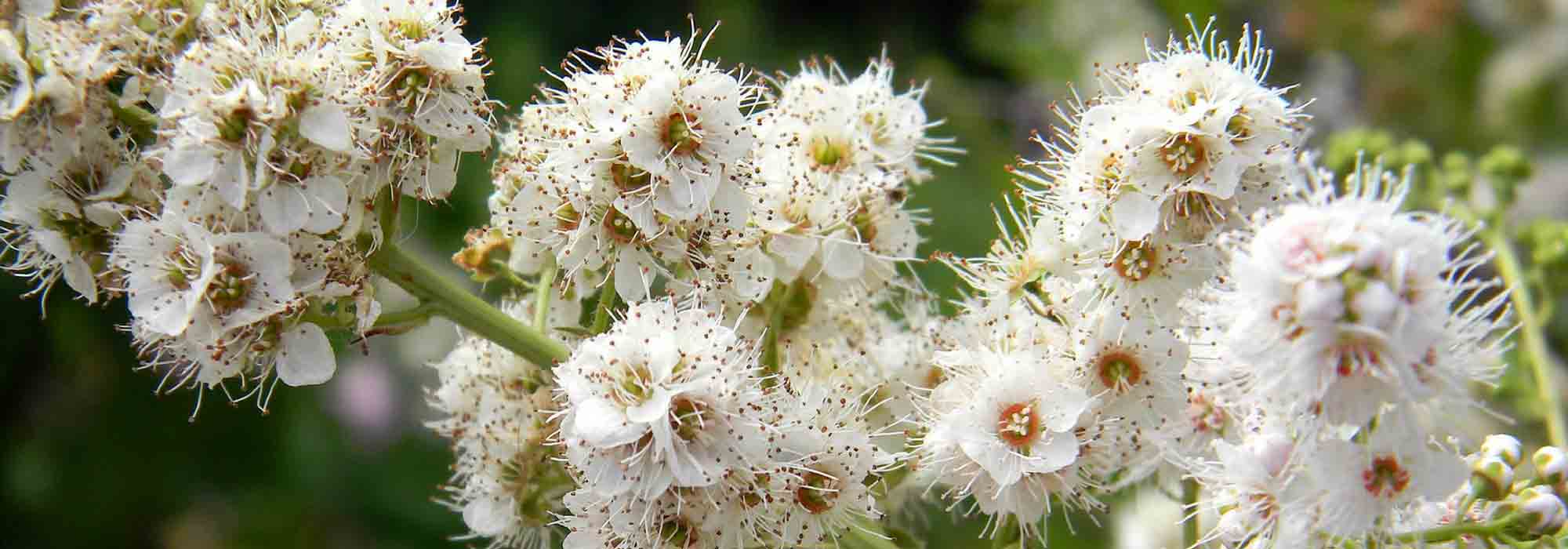
Spirea, Spiraea : planting, pruning and care
Contents
Spiraea in a nutshell
- Spiraea is a beautiful bushy plant with spring or summer flowering
- Very easy to grow, it is often one of the first bushes planted by beginner gardeners
- Hardy, it adapts to all climates and all soils
- Low-maintenance, it finds its place in all gardens, from small to very large
- It is perfect for informal hedges, borders, and for dwarf varieties, in beds or even in rockeries
A word from our expert
Spiraea is a vigorous bush that is easy to grow. It is valued for its generous spring or summer flowering, its compact habit, and its dense foliage, which is green or sometimes yellow in the case of the golden spiraea (Spirée ‘Goldflame’).
From March to August, depending on the species, the flowering in clusters of small pure white flowers of Van Houtte’s spiraea and the arguta spiraea, pink from the billiardii spiraea, literally covers this light and graceful bush. Not to mention the cultivars of Japanese spiraea or Spiraea japonica such as ‘Anthony Waterer’, undoubtedly the most widely grown of all Japanese spiraeas!
It is a very robust bush that truly withstands everything and adapts to any climate and almost all growing conditions.
Hardy down to about -20°C, the spiraea grows in full sun or partial shade in any well-drained ordinary soil. With a fairly rapid growth rate, it quickly forms beautiful, very floriferous green screens that are easy to prune.
Low-maintenance and versatile, this bush finds its place in all gardens, to create spiraea hedges or to brighten up a flower bed, border, rockery, or even a terrace.
It is a reliable bush, with well-deserved success as it is easy to cultivate while showing incredible generosity.
Description and Botany
Botanical data
- Latin name Spiraea
- Family Rosaceae
- Common name Spiraea
- Flowering from March to autumn depending on species
- Height 0.30 to 3 m
- Exposure Sun, partial shade
- Soil type All, well-drained
- Hardiness -20°-25°
The genus Spiraea comprises around 80 species of deciduous or semi-evergreen shrubs or shrubs growing in cool to occasionally moist areas, in ditches, on rocks, in thickets, at forest edges, along stream banks, or in open woodlands. Belonging to the Rosaceae family, spiraeas are native to temperate regions of Europe, Asia, and America, as well as Mexico.
The spiraea genus is highly diverse. Spring and summer spiraeas are distinguished, with some being ground cover, while others form beautiful bushes; most bear typical umbel flowers, while others have spikes. The genus includes a multitude of species such as Birch-leaved Spiraea (Spiraea betulifolia), Japanese Spiraea (Spiraea japonica), with white or pink flowers appearing in summer, Spiraea billardii, with summer pink spikes, Spiraea arguta, and Spiraea vanhouttei, with spring white flowering.
With a medium to fast growth, this graceful shrub with a bushy, upright, and compact habit forms a dense tuft, more or less rounded, ranging from 0.40 m in height to easily 2 to 3 m in height, with a spread of 2.50 m for the largest varieties. Some, like Spiraea x Vanhouttei, have a fountain-like habit, with branches elegantly curling at the tips to fall in an arch.
Over the years, the spiraea develops into large, impenetrable thickets. Some species tend to sucker and produce numerous shoots around the stump.

From left to right: Spirea japonica ‘Little Princess’ – Spirea vanhouttei – Spirea japonica ‘Anthony Waterer’ – Spirea billardii.
The intensely bright foliage forms a compact and attractive green backdrop in spring and autumn. The deciduous leaves, entire, slightly dentate, simple or clustered, emerge in spring on the numerous fine, upright, and often highly branched shoots.
Ranging from 1 to 12 cm long, they are oval to lanceolate or even diamond-shaped, with some, like Birch-leaved Spiraea, resembling those of dwarf birch.
Young shoots sometimes emerge coppery orange or brownish-red and unfold into leaves generally medium green to dark green or bluish green, sometimes greyish on the underside. Some varieties (‘Tor Gold’, ’Gold Fountain’) have golden or coppery foliage, changing throughout the seasons, passing through all shades of orange, fiery red, and purple from spring to autumn before falling.

Young foliage: Spirea japonica ‘Goldflame’ and Spirea japonica ‘Anthony Waterer’.
The spring or summer flowering is spectacular and very abundant. From March to June or from June to September, depending on the species, the shrub becomes completely covered with a multitude of flowers pure white, pale pink, bright pink to raspberry pink or intense red (Spiraea japonica Sparkling Champagne), which adorn the foliage for three weeks.
From a large bush of beautiful density, small cup-shaped flowers grouped in umbels emerge along the branches of the previous year for spring spiraeas, in small flattened clusters (corymbs) 3 to 20 cm wide or in very dense spikes 10 to 20 cm long, at the tips of the current year’s shoots for summer spiraeas.
Spiraea prunifolia Plena stands out from the others with its double, fluffy flowers, while Spiraea thunbergii ‘Fujino Pink’ is a lovely variety of Thunberg’s Spiraea whose early spring flowering somewhat resembles that of an apple tree.
Long stamens emerging from the flowers often give a fuzzy appearance to these inflorescences that are highly visited by butterflies, bees, and bumblebees.
The spiraea is one of the few shrubs that bloom in mid-summer. This prolonged flowering is recurrent in late summer, early autumn for summer spiraeas. In some, the flowering is so massive that it gracefully bends the branches towards the ground.
The flowering is followed by fruits of little interest, but highly appreciated by birds.
The spiraea is easy to cultivate, in sun or partial shade for golden-leaved spiraeas, in any fresh, well-drained soil. Very hardy down to -20°C-25°C, it grows very well in all our regions, provided conditions are not too arid.

For a rosaceae, it is robust, resistant to diseases and pests.
It is ideal for creating a countryside hedge or in shrub beds combined with perennials along paths, or even as a specimen in rockeries, or as a ground cover for ground-cover species. It will thrive very well in containers on your terraces and balconies.
Considered a sacred plant by druids, since the Renaissance, the Spiraea is also known for its healing and tonifying properties.
Main species and varieties
According to the species, the flowering of Spiraeas can be spring (from March to June) or summer (from June to September).
Spiraea vanhouttei, also known as Spiraea x vanhouttei, or Van Houtte’s spiraea with small white flowers in May and June, can reach 2 metres in height and 2.5 m in width, is the most well-known of all. With its fountain-like white flowering, it is very often used by landscapers for the greening of large slopes, along roads…
Alongside this essential, we find Spiraea x billardii with pink flowers in July, Spiraea betulifolia or birch-leaved spiraea, and Spiraea japonica with pink or white flowers in summer, which has given rise to many varieties (‘Firelight’, ‘Magic Carpet’) with light, golden, or even bronze foliage in autumn.
The modest development of Japanese spiraea (maximum height of 1 m) allows for use in small gardens.
The dwarf varieties (‘Nana’, ‘Little Princess’) can be used as ground cover, in miniature hedges, or even in pots.
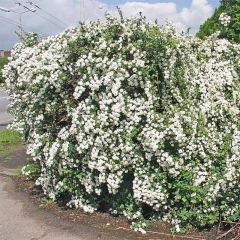
Spiraea x vanhouttei
- Flowering time May to July
- Height at maturity 2 m
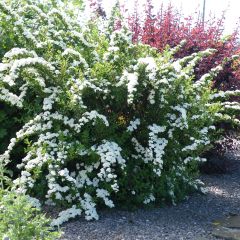
Spiraea nipponica Snowmound
- Flowering time May, June
- Height at maturity 2 m
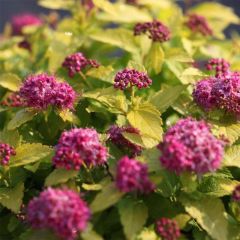
Spiraea japonica Double Play Gold
- Flowering time July to October
- Height at maturity 70 cm
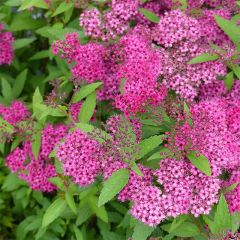
Spiraea japonica Anthony Waterer
- Flowering time July to October
- Height at maturity 1 m
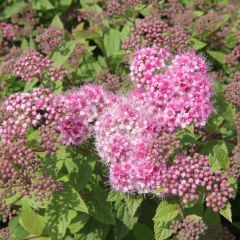
Spiraea japonica Nana
- Flowering time July to October
- Height at maturity 50 cm

Spiraea arguta
- Flowering time May, June
- Height at maturity 1,50 m
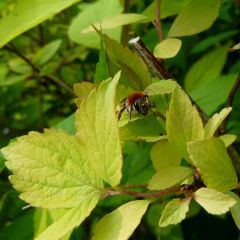
Spiraea (x) vanhouttei Gold Fountain
- Flowering time May to July
- Height at maturity 1,50 m
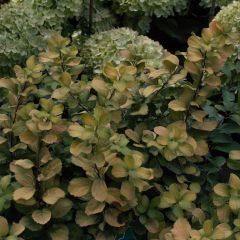
Spiraea betulifolia Tor Gold
- Flowering time June, July
- Height at maturity 80 cm
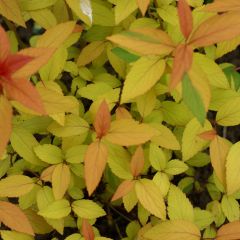
Spiraea japonica Magic Carpet
- Flowering time July to October
- Height at maturity 50 cm
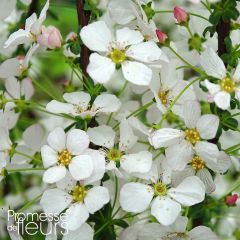
Spiraea thunbergii Fujino Pink
- Flowering time April, May
- Height at maturity 1,50 m

Spiraea japonica Sparkling Champagne
- Flowering time August to October
- Height at maturity 1 m
Discover other Spiraea
View all →Available in 2 sizes
Available in 1 sizes
Available in 3 sizes
Available in 0 sizes
Available in 3 sizes
Available in 1 sizes
Available in 1 sizes
Available in 5 sizes
Available in 1 sizes
Available in 1 sizes
Planting the spiraea
Where to Plant
Easy to grow, the Spiraea really withstands everything and adapts to most soils and climates.
It can be planted throughout France, except perhaps in Mediterranean climates, which can be too hot and dry in summer. With good hardiness, it can withstand very low temperatures of jdown to -20 °C, sometimes even lower depending on the growing conditions, ensuring perfect resilience in all regions.
This bush will thrive preferably in full sun, where it flowers best, although it tolerates partial shade, which is preferable for golden-leaved spiraeas, especially in hot climates.
Not demanding regarding soil type, the spiraea grows in ordinary soil that is neutral or acidic, rich, rather cool but not overly moist, and well-drained. It also adapts to poorer and drier soils and can tolerate some lime (except for Spiraea x billiardii).
Versatile, the Spiraea has its place in all gardens. In borders or as a free-standing hedge, allow the larger varieties space to grow to their full size.
The more modestly growing spiraeas are ideal for a small garden or planted in groups of 3 as stand-alone specimens on a lawn.
Compact species are perfect for rockeries. Dwarf forms make excellent ground covers on a slope, as well as border plants and miniature hedges, and adapt very well to pot cultivation on a balcony or terrace.
When to Plant
The Spiraea delivered as bare roots is preferably planted in autumn, from September to November for good rooting before winter, or in spring from February to April. Container-grown specimens can be planted all year round, between September and June. Avoid periods of severe frost and extreme heat.
How to Plant a Spiraea
In the Ground
- Dig a hole 2 to 3 times the volume of the pot or a trench for hedge planting
- Add potting soil and compost to the extracted soil
- Plant the spiraea at collar level in the centre of the hole
- Backfill and compact the soil well around the base
- Mulch to keep the base cool during summer
- Water generously at planting and regularly, as soon as the soil is dry on the surface, during the first year after planting to ensure establishment
For a Spiraea Hedge
- Depending on the varieties, space the plants 0.60 m apart, planting them in a staggered formation
- For ground cover, space the plants 0.50 m apart
In a Pot
The substrate should be fresh and well-draining. Choose small varieties like Spiraea japonica ‘Nana’.
- Place it in a large pot of at least 40 cm in diameter and depth
- Spread a good layer of drainage (gravel or clay balls)
- Plant in a mixture of soil and potting soil for shrubs, enriched with compost
- Mulch the base
- Water abundantly without allowing the substrate to dry out between waterings
- Repot every 2 or 3 years in early spring
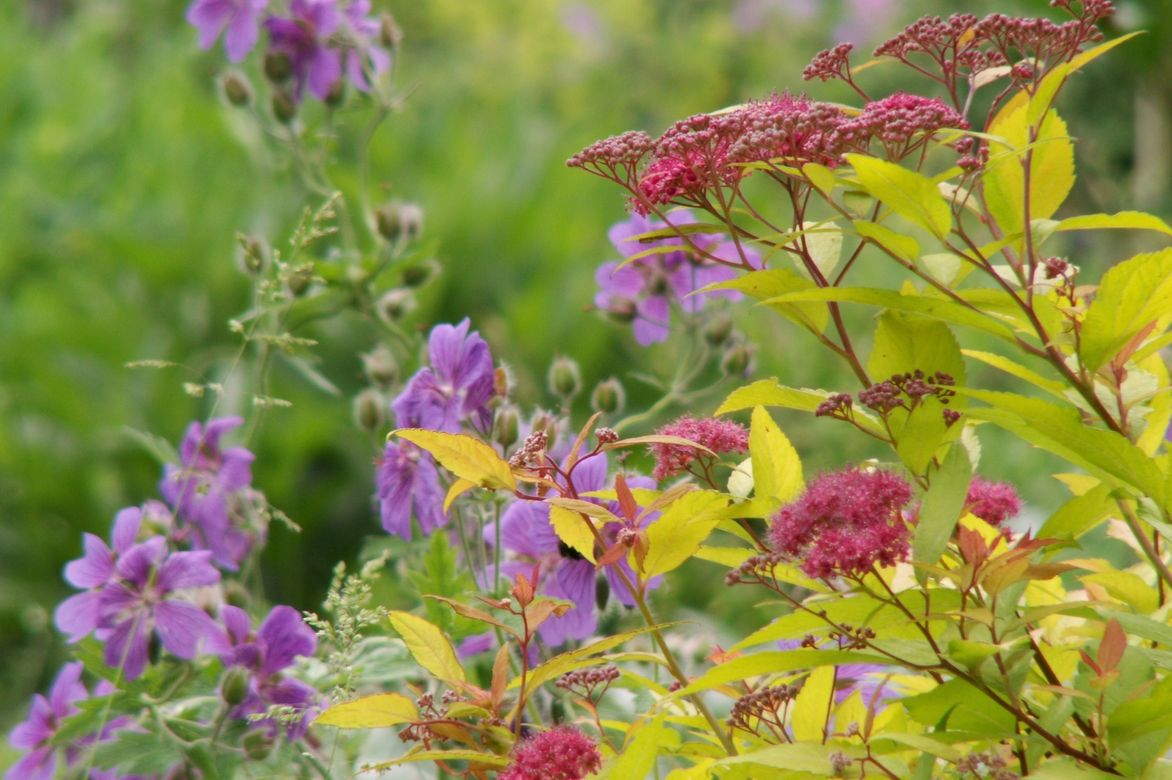
Spirea japonica ‘Goldflame’ accompanied by a Geranium magnificum.
Maintenance and care
Hardy down to -20°C, drought-resistant once well established, the Spiraea requires little maintenance.
In winter, the young shoots of early species and cultivars may, however, be damaged by late frosts.
Water every 15 days for the first two years after planting to ensure establishment. After that, the Spiraea will become increasingly resistant to drought.
The Spiraea adapts easily to all types of soils but prefers cool, not too dry soils. Be sure to mulch around the base of young plants to keep the soil moist in summer.
Every autumn, generous applications of compost or organic fertiliser in spring improve its growth and promote flowering.
For potted Spiraea, keep the root ball slightly moist at all times. Repot every year at the beginning of spring. In pots, nutrient reserves deplete quickly: to stimulate flowering, apply two handfuls of organic fertiliser (well-rotted manure, compost, horn…) twice a year, in spring and summer.
When and how to prune spireas?
Spiraeas may not require pruning; however, pruning allows for beautiful flowering and helps maintain a dense and compact habit.
Spring Spiraeas
Spring-flowering spiraeas are pruned in May-June, just after the flowers have fallen.
- Each year, after flowering, cut back the spent shoots, either trimming the tips of the shoot or cutting the shoot back to the base. To maintain the vigour of the young plant, also remove the old wood at the base.
- For an adult spiraea that is too bulky, cut back the shoots to one-third of their height. Spiraeas tolerate pruning very well, so do not hesitate to prune shorter if necessary.
Summer Spiraeas
Summer-flowering spiraeas are pruned either at the end of summer or at the end of winter. Remove the faded heads with shears just after flowering to encourage a slight resurgence of flowers in late summer or early autumn.
- Cut a few dead branches back to the ground every two years to allow light to penetrate and stimulate the growth of new branches.
- For an adult spiraea that is too bulky, cut back one-third of the shoots at the end of winter. Be careful, a heavy pruning will deprive you of flowers the following year; only carry out this operation if necessary and occasionally.
Diseases and potential pests
Spiraea is a robust plant that experiences neither diseases nor formidable pests. It may occasionally be attacked by scale insects and aphids, but this is not serious: apply soapy water sprays.
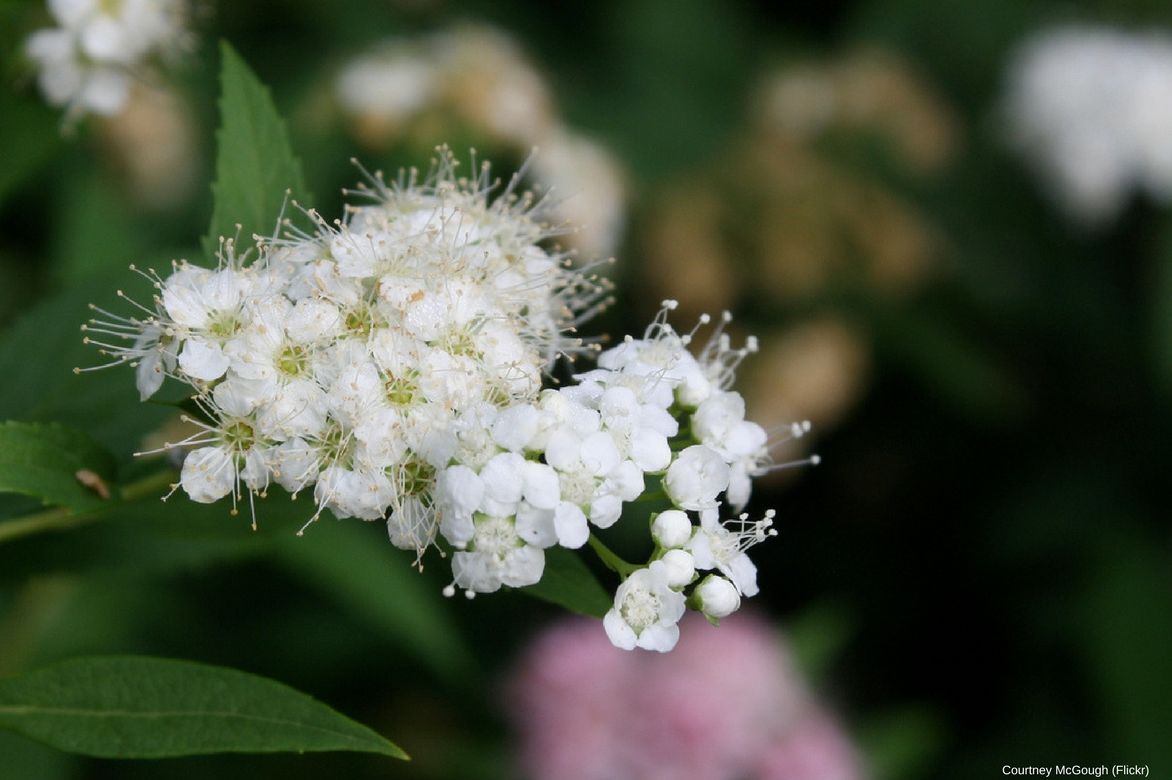
The Spirea japonica ‘Shirobana’ boasts flowers in shades of pink and white.
Multiplication: propagating spiraea
Some species of sucker-spreading spireas tend to layer naturally: at the beginning of spring, take these rooted stems and replant them immediately in the chosen location.
Additionally, you can easily propagate Spiraea by cuttings in June (spring spireas) or in August-September (summer spireas). This is the simplest and quickest technique.
By semi-woody cuttings
- Take just below an eye, the thin tip of a semi-ripe shoot of 10 to 15 cm (that is, in the process of transforming from softwood to hardwood)
- Make a cut at the base of the bark for 5 cm
- Remove the lower leaves but keep those at the tip
- Plant them in a well-draining mix of sand and special cutting compost
- Keep the substrate moist until rooting
- Transplant your cuttings into individual pots until the following autumn for their final planting in the garden
Associate it with the garden
With their abundant and bright flowering and dense foliage, Spiraeas are priceless in a spring scene as well as in summer compositions. They thrive in all natural and country gardens, creating wonderfully lush displays, imbued with freshness. They are top-notch for landscaping.
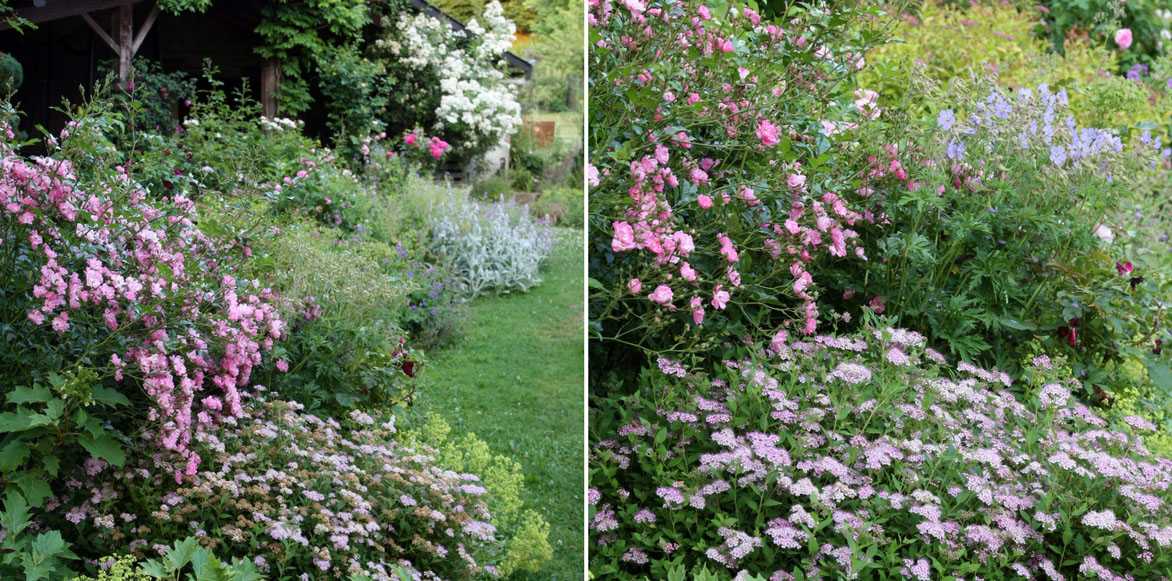
An example of a country association: Spirea japonica ‘Little Princess’, roses including ‘Castor’ in the foreground, Alchemilla mollis and hardy geraniums.
Summer spiraeas happily associate with other large summer-flowering shrubs, in a border or to adorn a large bank with Buddleias, Tamarix tetandra or large-flowered roses.
Planted in a narrow flower bed covered from head to toe in blooms, Spiraea nipponica ‘Snowmound’ with its arching branches contrasts beautifully against the undulating masses of a Céanothe arboreus Concha.
Surround them in a bed of easy-going shrubs that will precede or take over from their magnificent flowering, such as aFremontodendron californicum (in April-May-June), shrubby cistus (in May), Prunus triloba multiplex, Prunus x cistena, Prunus tenella, Ribes sanguineum. They lend themselves well to group plantings; mix the spiraeas together to stagger the flowering and ensure a season of blooms!
Spring-flowering species will pair wonderfully with mock oranges Philadelphus coronarius, Deutzia, viburnums, and barberries.

An example of an association in a free hedge: Philadelphus coronarius – Deutzia purpurascens ‘Kalmiiflora’ – Spirea vanhouttei – Berberis ottawensis ‘Superba’ – Viburnum opulus.
White-flowering spiraeas (Spiraea Cinerea ‘Graciosa’, Spiraea nipponica ‘Snowmound’) are essential for white and romantic gardens.
Cultivars of Spiraea japonica with green leaves and pink flowers (‘Double Play Gold’, ‘Anthony Waterer’) will be paired with the cool-coloured flowers of white or mauve roses, a dwarf lilac ‘Miss Kim’ and the silver foliage of a Buddleia ‘Silver Anniversary’.
Golden spiraeas (Spiraea betulifolia ‘Tor Gol’) will be accompanied in a country hedge by the sacred bamboo Nandina ‘Fire Power’ or the fluffy Eragrostis spectabilis.
In the foreground of a small hedge, accompany a Spiraea japonica ‘Nana’ with other dwarf spiraeas and a dwarf Weigela.
In a flowering border, combine them with Allium bulbs ‘Globemaster’ or christophii for their pom-poms, alongside hardy geraniums with blue-violet flowers, campanulas, a Penstemon ‘Garnet’, large late-flowering irises, yarrow, and summer lilies.

An example of a spring association: foliage of Spirea japonica ‘Goldflame’ and Iris pallida, Geranium magnificum and some Allium christophii.
Plant at its base a Clematis Diamantina or Clematis ‘Veronica’s Choice’ that will climb into its foliage and extend the display of its flowering.
Useful resources
- Discover our wide collection of spiraeas: you will find the most popular varieties among gardeners as well as some rare cultivars
- Advice sheet: How to choose a Spiraea?
- Subscribe!
- Contents































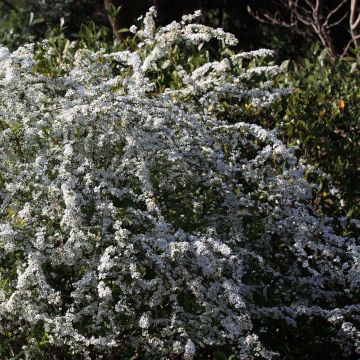


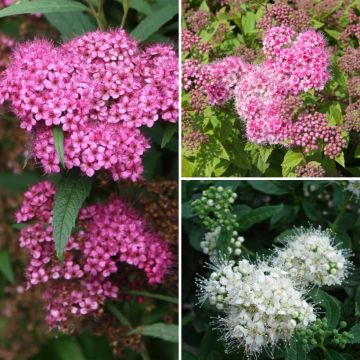
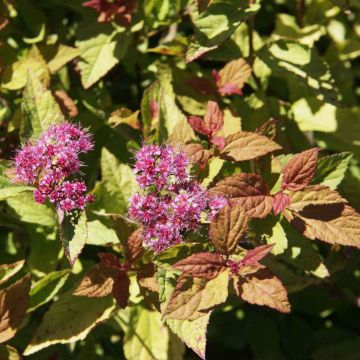

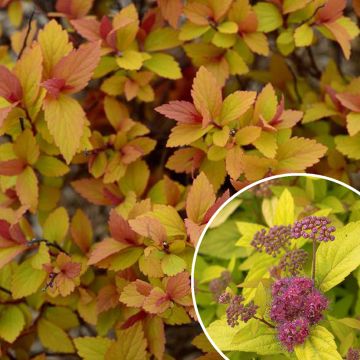
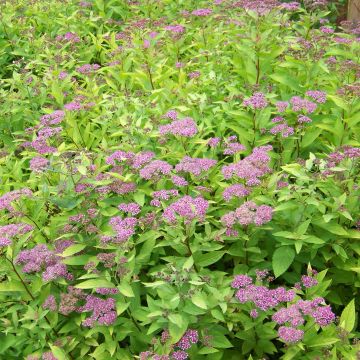

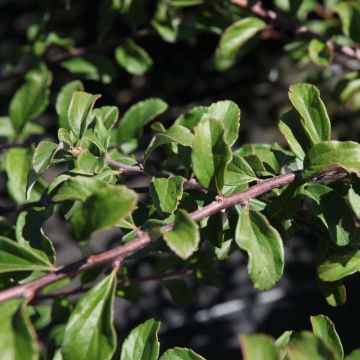
Comments